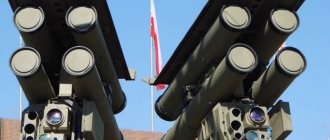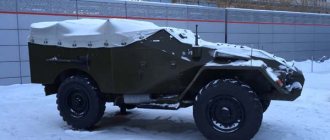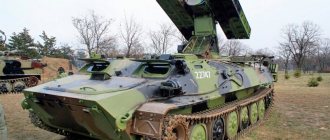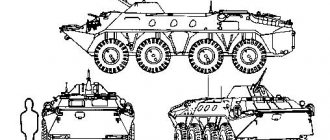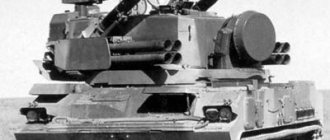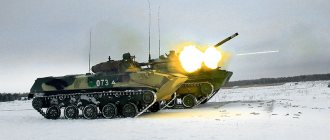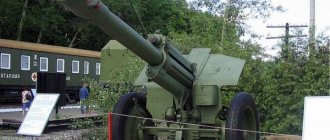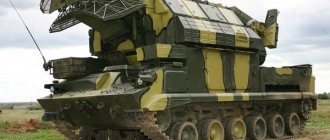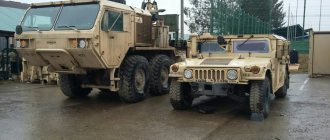| "Reflex-M" (9K119M) | |
| Main characteristics | |
| Type: | ATGM |
| Developer: | Instrument Design Bureau (Tula) |
| State: | In service |
| Years of operation: | 1990s - present |
| Launcher: | 125-mm smoothbore gun (T-64, T-72, T-80, T-90, 2A45M "Sprut-B", 2S25 "Sprut-SD" |
| Tactical and technical characteristics with 3UBK20 (3UBK20M) shot | |
| Weight (shot): | 24 kg (28 kg) |
| Weight (rocket): | 17.2 kg (?) |
| Caliber: | 125 mm |
| Average speed: | 284 m/s |
| Firing range: | 100-5000 m (75-5000 m) |
| Flight time at maximum range: | 17.4 sec (17.0 sec) |
| Control: | by laser beam |
| Warhead of the 9M119M1 "Invar-M1" missile | |
| Type: | tandem cumulative |
| Warhead mass: | more than 4.5 kg (?) |
| Armor penetration: | 900 mm or 800-850 for DZ[1] |
This term has other meanings, see Reflex.
Reflex-M
(GRAU index
9K119M
, according to the classification of the US Department of Defense and NATO
AT-11
Sniper , English Sniper) - a complex of guided tank missile weapons for combating tanks, helicopters, bunkers and other highly protected ground, surface or low-flying targets at long distances. The launch is carried out from a smoothbore gun of 125 mm caliber (T-64, T-72, T-80, T-90, 2A45M Sprut-B, 2S25 Sprut-SD, etc.). Developed at the Tula Instrument Engineering Design Bureau[2].
Rocket
The 9M119M "Invar" and 9M119M1 "Invar-M" rockets are solid fuel, made according to the "canard" aerodynamic design. The missiles are controlled semi-automatically using a laser beam. Particular attention was paid to the missile's noise immunity and the possibility of its use in various climatic conditions.
The warhead of both missiles is tandem cumulative - it carries 2 charges (leading and main). The leading charge is designed to destroy dynamic protection and anti-cumulative shields. The main charge penetrates the main armor and destroys equipment.
To destroy infantry, engineering structures and lightly armored vehicles, a version of the missile with a thermobaric warhead was developed.
During operation, the missiles do not require maintenance or inspection and remain combat-ready throughout their entire service life.
The 9M119M Invar missile was adopted for service in 1992, the 9M119M1 Invar-M1 missile in the second half of the 1990s.
The flight path is a spiral.
Notes
- , With. 187.
- , With. 174.
- Spandrel
literally means “above structure”, “sinus of the vault”. - ↑
- ↑. Official website of the Tula Arms Plant. Retrieved January 27, 2013.
- The Military Balance 2010. - P. 176.
- The Military Balance 2010. - P. 245.
- The Military Balance 2020. - P. 178.
- The Military Balance 2010. - P. 178.
- The Military Balance 2010. - P. 122.
- ↑ Error in footnotes?: Invalid tag ; no text provided for footnotes
- The Military Balance 2010. - P. 140.
- The Military Balance 2010. - P. 311.
- The Military Balance 2020. - P. 205.
- The Military Balance 2010. - P. 360.
- . MESHWAR. Retrieved August 21, 2012.
- The Military Balance 2010. - P. 251.
- The Military Balance 2010. - P. 365.
- The Military Balance 2020, p.187
- The Military Balance 2010. - P. 412.
- The Military Balance 2010. - P. 302.
- The Military Balance 2010. - P. 262.
- The Military Balance 2010. - P. 188.
- The Military Balance 2010. - P. 153.
- The Military Balance 2010. - P. 223.
- The Military Balance 2010. - P. 227.
- The Military Balance 2010. - P. 157.
- The Military Balance 2010. - P. 272.
- The Military Balance 2010. - P. 159.
- The Military Balance 2010. - P. 372.
- The Military Balance 2010. - P. 189.
- The Military Balance 2010. - P. 125.
- The Military Balance 2010. - P. 196.
- The Military Balance 2010. - P. 307.
Application tactics
In a tank battle, the firing range determines the opening line of fire. At the same time, tanks with a shorter firing range are forced to advance to this line under enemy fire, effectively turning into moving targets. Considering that the maximum firing range of 120-mm tank guns with conventional shells (armor-piercing sub-caliber or cumulative) is about 3000 m, the use of the Reflex complex gives a head start of almost 2 kilometers, which in time terms is about 2.5-4 minutes. During this time, each tank manages to fire 5-10 missiles (taking into account the time it takes for the missile to fly to the target) at the enemy.
Notes
Sources
- , With. 174.
- ↑
- ↑
- ↑ Weapons of Russia, 2012
- . Look (July 3, 2014). Retrieved July 4, 2014.
- (unavailable link). Information and news system “Rocketry”. Retrieved January 8, 2013.
- ↑ ATGMs of the Ground Forces / ed. Dmitrieva G.N. - Kyiv: Archive-Press, 1997. - P. 26. - 26 p. — (Archive 500+). — 700 copies.
- International Institute for Strategic Studies.
The Military Balance 2020 / James Hackett. - London: Taylor&Francis. - pp. 182,183. — ISBN 9781857438352. - International Institute for Strategic Studies.
The Military Balance 2020 / James Hackett. - London: Taylor&Francis. - P. 108. - ISBN 9781857438352. - (English) (inaccessible link). Deagel.com. Retrieved February 29, 2012.
- International Institute for Strategic Studies.
The Military Balance 2020 / James Hackett. - London: Taylor&Francis. - P. 332. - ISBN 9781857438352. - International Institute for Strategic Studies.
The Military Balance 2020 / James Hackett. - London: Taylor&Francis. - P. 188. - ISBN 9781857438352. - International Institute for Strategic Studies.
The Military Balance 2020 / James Hackett. - London: Taylor&Francis. - P. 190. - ISBN 9781857438352. - International Institute for Strategic Studies.
The Military Balance 2020 / James Hackett. - London: Taylor&Francis. - P. 205. - ISBN 9781857438352. - International Institute for Strategic Studies.
The Military Balance 2020 / James Hackett. - London: Taylor&Francis. - P. 121. - ISBN 9781857438352.
Operators
- Azerbaijan Azerbaijan - 20 9P148 combat vehicles and 400 9M113 missiles
- Algeria Algeria - a number of 9K111-1 “Competition” complexes, as of 2010,
- Armenia Armenia - 9 9P148 combat vehicles, as of 2016
- Belarus Belarus - a number of 9K111-1 “Konkurs” complexes, as of 2010
- Bulgaria Bulgaria - 236 complexes 9K111 "Fagot" and 9K111-1 "Konkurs", as of 2010, 400 ATGM 9M113 were produced under license for the period from to 1996
- Hungary Hungary - 100 combat vehicles and 2060 9M113 missiles were supplied from the USSR between 1988 and 100 9K111-1 Konkurs complexes are still in service as of 2010
- Guinea Guinea - a number of 9M113 ATGMs, as of 2010
- Georgia Georgia - some 9M113, as of 2017
- GDR GDR - 52 9P148 combat vehicles were supplied from the USSR in the period from to 1983, 11,200 9M113 missiles were supplied from the USSR in the period from to 1989
- Egypt Egypt - 580 9M113 missiles for Fahd armored personnel carriers supplied from Russia between 1995 and 1995
- India India - 110 SPTRK based on BRDM-2 with 9M111 and 9M113 missiles (presumably 9P148), as of 2010, 1000 9M113 missiles were supplied from the USSR between 1991 and 1991. 25,000 9M113 missiles ordered from the USSR in 1988, produced under license since 1992 (including the 9M113M version), as of 2011, 12,800 missiles were produced
- Iraq Iraq - were in service with the Iraqi army during the Gulf War
- Iran Iran - a number of 9K111-1 “Konkurs” complexes, as of 2010, missiles are produced under license under the designation Towsan-1, between 2011 and 2400 9M113 units were produced
- Kazakhstan Kazakhstan - a number of 9K111-1 “Konkurs” complexes, as of 2010
- Kyrgyzstan Kyrgyzstan - 12 units 9K111-1 “Competition”, as of 2020
- DPRK DPRK - a number of 9K111-1 “Konkurs” complexes, as of 2010
- Cote d'Ivoire Cote d'Ivoire - a number of 9K111-1 "Competition" complexes, as of 2010
- Libya Libya - a number of 9K111-1 “Competition” complexes, as of 2010
- Moldova Moldova - 19 9K111-1 “Competition” complexes, as of 2010
- Morocco Morocco - 100 9M113 missiles delivered from Russia in 2001
- Poland Poland - 800 9M113 missiles were supplied from the USSR between 1989 and 1989; as of 2010, 18 9K111-1 Konkurs complexes are still in service
- Russia Russia: Ground Forces of the Russian Federation - a number of 9K111-1 “Konkurs” complexes, as of 2010
- Coastal forces of the Russian Navy - 72 complexes 9K11 "Malyutka" and 9K111-1 "Konkurs", as of 2010
Launchers.
- 9P161 -
Self-propelled ATGM 9K128 Kornet-S on the BMP-3 chassis with two launchers, each with 1 guide and automatic loader
. - 9P162 -
Self-propelled ATGM 9K128-1 Cornet-T on the BMP-3, BTR-80 chassis with two launchers, each with 1 guide and automatic loader
. - 9P162M -
Self-propelled ATGM Kornet-D1 on the BMD-4M chassis
. - 9P163 -
Portable ATGM 9K129 Cornet-P with 1 guide
. - 9P163-1 -
Portable ATGM 9K129-1 Cornet-P with 1 guide.
Experienced self-propelled ATGM 9K135 Vest on a UAZ-3151 chassis with 4 guides and an automatic loader . - 9P163-2 Quartet -
Combat module of the Kornet\Kornet-E ATGM with 4 guides and an automatic loader for placement on light carriers
. - 9P163-2M Quartet-M -
Combat module of the Kornet-D\EM ATGM with 4 guides and an automatic loader for placement on light carriers
. - 9P163-3 -
Self-propelled ATGM Kornet-D1\EM on the VPK-233116\VPK-233136 Tiger-M chassis with two launchers, each with 4 guides and an automatic loader. - 9P163M-1 -
Portable and portable ATGM Kornet-P\E with 1 guide
. - 9P163M-2 -
Portable and portable ATGM Kornet-D\EM with 1 guide
.
Composition[ | ]
Combat vehicle 9P148 |
Main article
9P148 “Competition” Launcher 9P148
Launcher body 9P148
The Konkurs ATGM is modified in relation to the basic
BRDM-2
.
The changes ensure the placement of the launcher, sighting device, as well as electric drives for their guidance and synchronization. A cutout was made in the original body roof sheet for the exit of the launch guides. The cutout is covered by a rectangular electrically operated hatch. The commander's hatch contains a 9Sh119
with the ability to quickly move roughly manually along the horizon, or smoothly track the target using an electric drive. The sight in the stowed position is closed by an armored shutter with a manual drive. In order to protect the optics, there is a “combat glass” that is opened only during combat work, also manually. A light filter is provided to protect the gunner's vision from the effects of light radiation from a nuclear explosion, laser radiation, etc. The filter drive is also manual.
Launcher 9P135 |
Starting guides on the roof of the 9P148 housing
Hardware part of the 9P148
made on the basis of portable installation units
9P135
placed in the housing.
Also included in the kit is a 9P56
from the portable version. Thus, it is possible to fully use the anti-tank system outside the combat vehicle, for which it is necessary to dismantle the sighting device, control equipment, remove the machine from the stack and assemble the launcher. No special tools are required for this - all blocks are secured with wing nuts, the sight is removed upward through a special hatch in its turret using a standard turret key.
In addition to standard installation blocks 9P135
, the BM “Competition” contains special blocks:
- light interference indication unit (allows you to detect light interference that interferes with the semi-automatic guidance of the missile at the target);
- built-in equipment for monitoring and testing starting circuits;
- electromechanical guidance and synchronization drives.
The ability to test start-up circuits allows you to check the performance of the entire start-up procedure chain without actually starting up the products. Since the recoilless principle is used to launch a rocket, the launch is accompanied by the emission of a flame torch from the end of the container at approximately 10-15 m. In this regard, reliable insulation of the engine and combat compartments from the effects of flame is extremely important. Checking the start-up circuits allows you to diagnose malfunctions of the air intake protective shutter reset mechanism, breaks in the lines of the limit switches of the “travelling” locking mechanisms and the signaling for closing crew hatches and weapons.
ATGM 9M113 |
ATGMs 9M14P1, 9M113M and 9M113 in the Tula State Museum of Weapons
Missiles of the 9M113
, 9M111 (and their modifications) are widely described in the literature. The startup process deserves a separate description. Complicated at first glance, it ensures the product is launched only after all the procedures necessary for a reliable start have been fully worked out, and excludes the product from being launched in the event of any malfunctions.
- When the operator presses the “start” button, the electrical circuit of the squib of the hinged front cover of the TPK is closed, the cover opens, releasing the push rod of the squib contact of the power supply compartment (it also contains the Ш9 connector, which ensures switching of the electrical circuits of the rocket and the combat vehicle).
- Under the influence of the squib pulse, the separated batteries close and supply power to the on-board network of the product. The gyro powder generator ignites. After spinning up the gyroscope to operating speed (about 10,000 rpm), the inertial contactor switches the fuse of the expelling charge.
- The expelling charge ignites, pushing the product out of the TPK.
- The main engine is ignited by its own inertial contactor after the missile reaches a speed of about 300 m/s (which occurs at a distance of approximately 70 m from the firing position).
